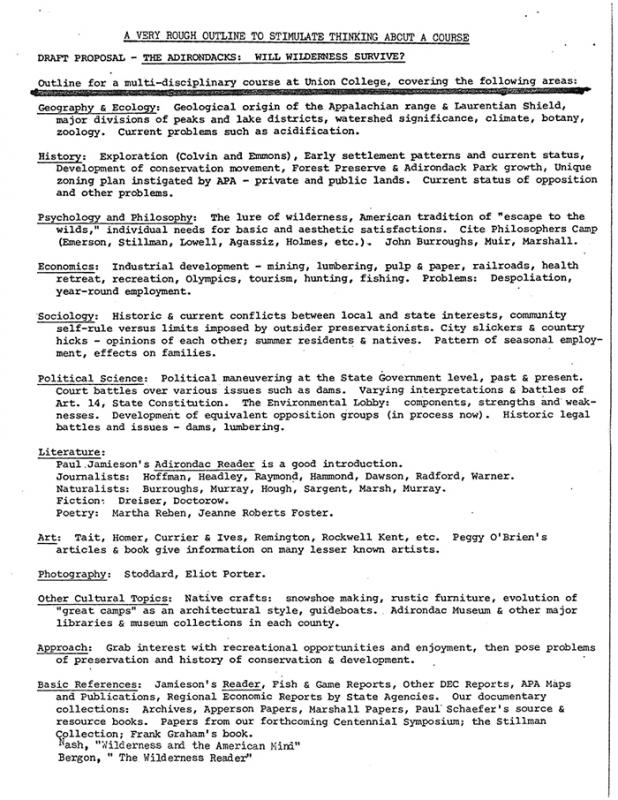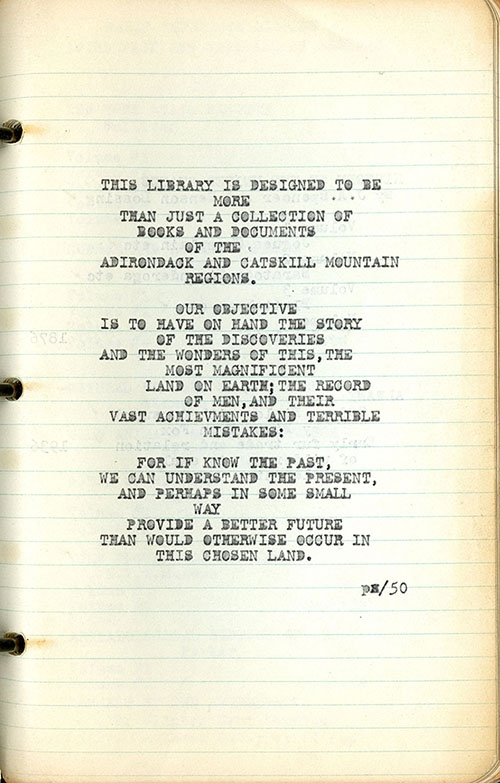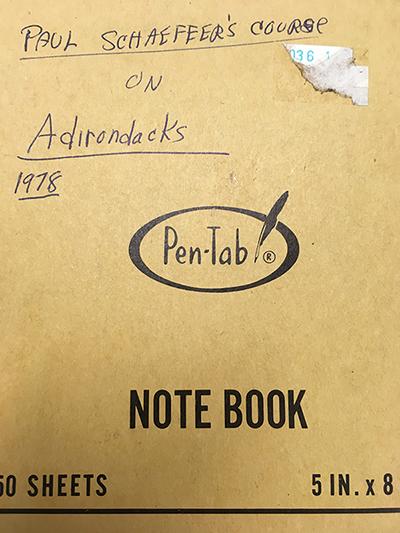The Paul Schaefer Library and the Genesis of ARL
Continuing to work through historical collections at the Adirondack Research Library, I have come across something fascinating that lies at the core of the present daily operations. A red binder sits quietly in a heap of records in the archives. Forgotten and lost to time. Until a chance discovery - a brilliant mission statement from the past comes stirring back to life.
This library is designed to be
more than just a collection
of books and documents
of the Adirondack and
Catskill Mountain regions.
Our objective
is to have on hand the story
of the discoveries
and the wonders of this, the
most magnificent
land on earth; the record
of men, and their vast achievements
and terrible mistakes:
For if [we] know the past,
we can understand the present,
and perhaps in some small
way provide a better future
than would otherwise occur in
this chosen land.- Paul Schaefer
The Adirondack Research Library in its present form is the culmination of many years of careful curation by those who fought to keep the Adirondacks forever wild. It began however as one person’s mission to accumulate as much information as possible about a beloved land which transformed his life, this was Paul Schaefer.
“This land, I had been told, belongs to the people. It was part of the New York State Forest Preserve and protected by the New York State Constitution. Then it was our land. I decided that I must learn as much as possible about the land and that I would begin a library about the Adirondacks. I started my search for Adirondack books. The wise, old Albany bookseller, John Skinner, sympathetic to my desire to start a library had convinced me that my first book on the Adirondacks ought to be one he had – an autographed copy of Verplanck Colvin’s 1873 report to the legislature. I paid for it in installments over a period of about a month. I took the book home and soon knew it almost by heart.”1
Paul Schaefer (1908-1996) first came to the Adirondacks in 1920 following illness in the family. Suffering from tuberculosis, it was hoped the clean mountain air would improve his mother’s health. Living on the edge of the Siamese Ponds Wilderness, he soon found he thrived in the back country. Craving to learn more, he began to read every publication he could on the Adirondacks without discrimination by the type of publication whether it be a technical, natural science, or environmental literature and philosophy title.2 Thus began his personal collection which would eventually become the cornerstone of the Adirondack Research Library as we know it today.
In the 1930s, Schaefer volunteered to help in the battle against New York’s Closed Cabin Amendment and was quickly taken under the wing of seasoned environmental activist, John Apperson, Jr. Soon he became one of the leading figures of the conservation movement.3 Throughout his many battles to fight development and destruction of the Forest Preserve and Adirondack Park, his collection of reference materials accumulated steadily.
Paul Schaefer formed the Friends of the Forest Preserve in 1945 to lead the fight against the proposed Higley and Panther Mountain Dams. Running the organization out his home in Niskayuna, it was also the site of the organization’s reference library. It is this collection, referred to as the New York State Forest Preserve Legislative and Historical Reference Library, that the red binder comes from. According to a release from the Friends of the Forest Preserve:
“When this little stone house was constructed in 1934 it became an embryo library and occasional hospice for several mountaineers from the Adirondacks. As family and business interests increased, wings were added to the original house and a place for a library and strategy room became available. The rural-like setting, its adjacence to a wildlife sanctuary and its half hour proximity to state offices and the capitol helped assure its acceptance to those invited.” 4
This early library was modest, but would form the basis for the later fully developed ARL collection which would eventually contain both these reference titles as well as the Archives of the Association for the Protection of the Adirondacks, rescued from oblivion during the closing of their offices in New York City.
The collection titles soon extended beyond the confines of the binder. More lists of acquisitions were added after the volume had been filled and stuffed into the pockets. The collection was broken down into these categories: Basic; State; General; Maps and Trails; Paintings, Sketches, Etchings, Etc.; Adirondack Magazines; The Catskills; and Miscellaneous.
Even at this early stage, Schaefer showed a proclivity for collection development with a wide range of titles that gave a comprehensive approach to the subject. Copies from state archives included public papers of governors of New York State with references to the Forest Preserve. Most of Verplanck Colvin’s publications seem to have been collected as well. In the pre-internet age, such a specialized collection of information was a sorely needed, and much appreciated resource. With the information in hand, activists were able to effectively lobby and shut down bills which would damage the Park.
In the fall of 1978, Paul taught a non-credit course entitled The Adirondack – the Land Nobody Knows. His enthusiasm soon spread to the Union College Community and shortly after the college agreed to establish a special Adirondack Collection, with a large donation of materials from Schaefer. The Adirondack Research Center at Schaffer Library would last from 1979 to 1985. It was then moved to the Schenectady Museum from 1985-1989. From 1989-2003 the collection again moved to rented space on Roland Place until finally returning to his home which had been expanded, once again, to house the Association for the Protection of the Adirondacks’ Center for the Forest Preserve in 2004. In 1995, the Adirondack Research Center was rebranded as the Adirondack Research Library. In 1996 Paul Schaefer passed away, leaving the remainder of his books, papers, and photos to the collection.5
And the rest as they say, is history.
1 Schaefer, Paul. Defending the Wilderness: The Adirondack Writings of Paul Schaefer. (Syracuse University Press, 1989): 10.a
2 Schaefer, Paul. Adirondack Cabin Country. (Syracuse University Press, 1993): 37. 3 “Wild at Heart: The Education of Paul Schaefer”. Grassroots Activism and the American Wilderness, Union College, https://muse.union.edu/arl-collections/abstract-4/ 4 Protect the Adirondacks! Inc. Records, 1901-2011, Adirondack Research Library of the Kelly Adirondack Center at Union College, Schenectady, NY. 5 Pilcher, Edith. A Centennial History of the Association for the Protection of the Adirondacks, 1901-2003. (Association for the Protection of the Adirondacks, 2003): 51-54.
Featured Photos


